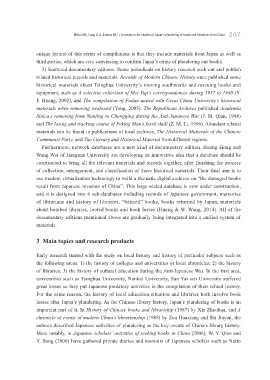Page 208 - JOURNAL OF LIBRARY SCIENCE IN CHINA 2015 Vol. 41
P. 208
Mikun MA, Gang LI & Jianhua WU / A review on the studies of Japan’s plundering of books and literatures from China 207
unique feature of this series of compilations is that they include materials from Japan as well as
third parties, which are very convincing to confirm Japan’s crime of plundering our books.
3) Scattered documentary editions. Some periodicals on history research seek out and publish
related historical records and materials. Records of Modern Chinese History once published some
historical materials about Tsinghua University’s moving southwards and rescuing books and
equipment, such as A selective collection of Mei Yiqi’s correspondences during 1937 to 1940 (Y.
F. Huang, 2002), and The compilation of Fudan united with Great China University’s historical
materials when removing westward (Yang, 2005). The Republican Archives published Academia
Sinica’s removing from Nanjing to Chongqing during the Anti-Japanese War (J. M. Qian, 1998)
and The losing and tracking course of Peking Man’s fossil skull (Z. M. Li, 1996). Abundant related
materials can be found in publications of local archives, The Historical Materials of the Chinese
Communist Party, and The Literary and Historical Material from different regions.
Furthermore, network databases are a new kind of documentary edition. Huang Hong and
Wang Wei of Jiangnan University are developing an innovative idea that a database should be
constructed to bring all the relevant materials and records together, after finishing the process
of collection, arrangement, and classification of those historical materials. Their final aim is to
use modern virtualization technology to build a thematic digital archives on “the damaged books
result from Japanese invasion of China”. This large-scaled database is now under construction,
and it is designed into 6 sub-databases including records of Japanese government, memories
of librarians and history of libraries, “banned” books, books returned by Japan, materials
about bombed libraries, looted books and book losses (Huang & W. Wang, 2014). All of the
documentary editions mentioned above are gradually being integrated into a unified system of
materials.
3 Main topics and research products
Early research started with the study on local history and history of particular subjects such as
the following areas: 1) the history of colleges and universities or local chronicles; 2) the history
of libraries; 3) the history of cultural education during the Anti-Japanese War. In the first area,
universities such as Tsinghua University, Nankai University, Sun Yat-sen University suffered
great losses so they put Japanese predatory activities in the compilation of their school history.
For the same reason, the history of local education situation and libraries both involve book
losses after Japan’s plundering. As for Chinese library history, Japan’s plundering of books is an
important part of it. In History of Chinese books and librariship (1987) by Xie Zhuohua, and A
chronicle of events of modern China’s librarianship (1988) by Zou Huaxiang and Shi Jinyan, the
authors described Japanese activities of plundering as the key events of China’s library history.
More notably, in Japanese scholars’ activities of seeking books in China (2006), W. Y. Qian and
Y. Song (2006) have gathered private diaries and memoirs of Japanese scholars such as Naito

